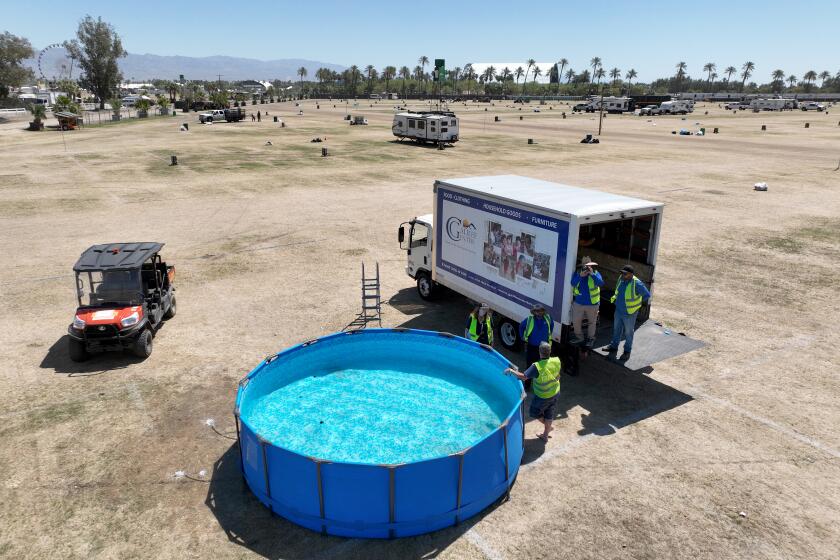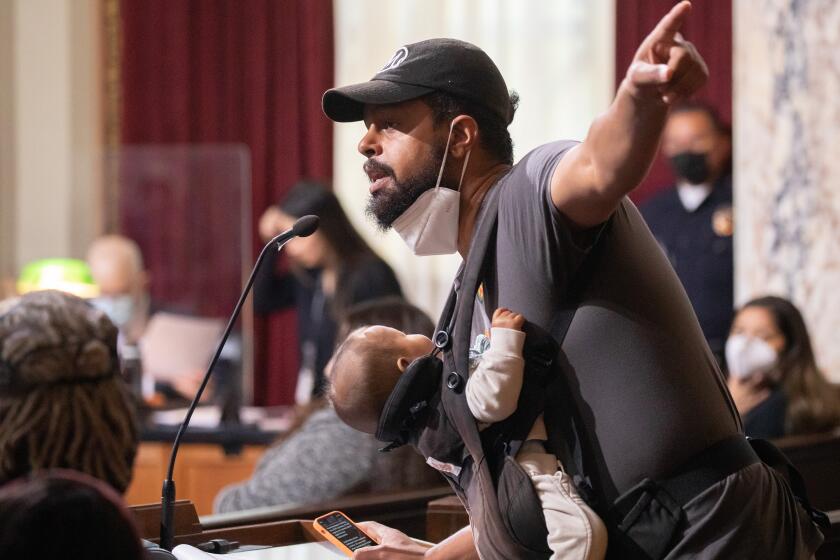Bratton to Ban Metal Flashlights
Los Angeles Police Chief William J. Bratton said Tuesday that he would prohibit officers from carrying large metal flashlights of the type used by an LAPD patrolman to club car theft suspect Stanley Miller -- a beating that was captured on videotape and broadcast internationally.
Bratton told members of the Los Angeles Police Commission that he would soon require officers to carry smaller, rubber flashlights that could not be used as weapons.
“There is a stigma attached to these flashlights that won’t go away,” Bratton said after he displayed a metal flashlight like the one used to hit Miller and compared it to a much smaller one measuring about 6 inches.
Tuesday’s announcement was the first time in Bratton’s two-year tenure that he has moved to reform police procedures in response to widespread public criticism, in this case based on the televised videotape.
Last year, he quickly advanced a preexisting plan to restrict police chases after several that were televised ended in crashes and injuries.
In deciding to ban large, club-like flashlights, the LAPD is following major metropolitan police departments including Philadelphia, Chicago, Miami and Detroit, which have banned them after highly publicized incidents involving their use as weapons.
Bratton said he will enact the ban after he receives a report now underway reviewing policies of other police departments.
The move drew a mixed response from civil rights advocates, several of whom had compared the Miller case to the 1991 beating of Rodney G. King.
John Mack, president of the Los Angeles Urban League and the chairman of a special committee investigating the Miller incident, described Bratton’s announcement as a “positive step in the right direction,” but said the case has revealed systemic flaws at the LAPD.
One such flaw, Mack said, was that LAPD policy does not state a minimum penalty for officers found guilty of brutality or excessive force.
Ramona Ripston, executive director of the American Civil Liberties Union of Southern California called the move “the right step at the right time” and said Bratton was right to ensure that flashlights are not used as instruments of force.
“The effectiveness of a law enforcement agency or police department really depends, to some extent, on how the public perceives them,” Ripston said. “If the public perception is that the department misuses equipment to brutalize them, it’s not going to be helpful to the department.”
Others described the flashlight ban as a case of window dressing by a politically savvy police chief.
“It’s more symbolism than substance,” said Earl Ofari Hutchinson, a political analyst and president of the National Alliance for Positive Action.
“The problem is not the flashlight -- it’s who is wielding the flashlight. It could have been any object,” Hutchinson said.
The incident that prompted Bratton’s move Tuesday occurred at 6 a.m. on June 23. Miller, 36, is seen on the video jumping out of his car after a pursuit and sprinting along Compton Creek, a concrete wash, before officers catch him.
The video shows one officer tackling Miller, who had stopped running and raised his hands, while a second officer jumps on him as well. At that point, Officer John Hatfield runs into the frame, kicks at Miller, kneels and begins swinging his flashlight like a hammer, striking Miller 11 times as he is held to the ground.
After the arrest, Hatfield and other officers told investigators that they believed Miller was armed and that they feared for their lives.
Hatfield has been relieved of duty pending the outcome of the investigation.
The use of heavy flashlights as weapons has been a matter of controversy in police departments nationwide, with a 1985 study in the Journal of Police Science and Administration declaring that they caused more injuries than police batons.
“If the flashlight is swung such that it strikes the skull at an angle, the possibility of a fracture of the skull is very likely and almost a certainty if the blow is delivered near the eye socket or the temporal region of the head,” the study concluded.
The New York Police Department, the nation’s largest and one Bratton once led, prohibits officers from using flashlights or radios as “impact weapons” except in life-and-death situations.
In 1995, Detroit’s police chief barred officers from carrying large flashlights, specifically any metal flashlight that used C or D batteries, after the fatal beating of motorist Malice Green by two officers who were later convicted in his death.
In 1998, after a lawsuit, the Chicago Police Department prohibited its officers from using or having in their possession any flashlight made of metal or metal alloy except for a small AA-battery flashlight.
Since the beginning of 2002, there have been 46 incidents in which LAPD officers wielded flashlights against suspects.
Yet the LAPD manual of procedures makes no specific mention of their use as weapons.
Bratton said that as part of the LAPD policy change, the department would consider the length and weight of the flashlights as well as the type of material.
“Will some officers be unhappy?” Bratton said. “Probably. That’s too bad.”
“I’m trying to keep the cops out of harm’s way as much as I am trying to protect the public,” Bratton said.
Who will bear the cost of the new equipment is yet to be determined.
Alan Skobin, Police Commission vice president, said the changes were necessary given the flashlights’ “apparent misuse by a small number of officers.”
Erwin Chemerinsky, a longtime USC law professor who recently took a post at the Duke University School of Law, applauded Bratton’s swift action on the flashlight policy.
“It’s an appropriate move and a desirable move in light of what we saw on the videotape,” Chemerinsky said.
“I think Bratton is the first chief in Los Angeles that would have done this and done this so quickly. I don’t think the prior chiefs would have done it in this way. It shows that Bratton sees excessive force as a problem and wants to deal with it aggressively.”
By Tuesday afternoon, news of the policy shift was still filtering down to department officers.
Police union President Bob Baker said he wanted to review the new policy to make sure that the department didn’t throw “the baby out with the bathwater.”
More to Read
Start your day right
Sign up for Essential California for news, features and recommendations from the L.A. Times and beyond in your inbox six days a week.
You may occasionally receive promotional content from the Los Angeles Times.








